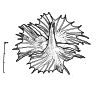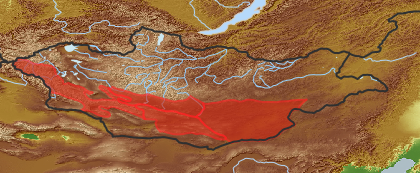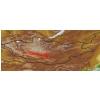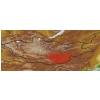| Class: | angiosperms |
| Order: | Caryophyllales |
| Family: | Chenopodiaceae |
| Genus: | Salsola |
| Scientific name: | Salsola ikonnikovii Iljin |
| Name acc. to: | Gubanov 1996 |
| Herbar: | list records  |
| Description: | Like S. tragus but plants rather glaucous and few branched. Bracts and bracteoles of dense spicate inflorescence strongly deflexed. Fruiting perianth forming a central cone. |
| Confuse with: | Young plants can be confused with S. tragus. |
| Tax. Comments: | FloraGREIF accessible material of Mongolia (HAL, GFW) does not include this species. But the specimens studied by Rilke (1999) are includet here and also photo material of LE.
 |
| Comments: | Distributed in southernmost part of Mongolia. |
| Link to Flora of China: | http://www.efloras.org/browse.aspx?flora_id=2&name_str=Salsola+ikonnikovii |
| open map in a new window |  |
| Habitat: | Barkhan, hillocky, mobile and half-fixed sands (Grubov 2001). |
| Habit (i)general appearance of a plant | |
| Growth form: (i)Herb, shrub, tree or climber. | annual (i)Completing its life cycle within one year or one growing season; roots weak and thin
herb (i)Herbaceous, erect plant, up to 2m high, mostly with a leafy shoot; if perennial, shoots die to the ground each season, shoots are not woody
example: Artemisia pectinata 
acc. to: FoC online |
| Parasite status: (i)Is the plant a half- or full parasite? | no parasite/saprophyte (i)Plant fully autonomous, leaves with chlorophyll
example: Most plants, Ranunculus  inherited by family Chenopodiaceae: no parasite/saprophyte inherited by family Chenopodiaceae: no parasite/saprophyte
|
| Water or terrestrial plant: (i)Where do the plants grow? | terrestrial (i)Plant grows on dry land
example: Orostachys spinosa  inherited by family Chenopodiaceae: terrestrial inherited by family Chenopodiaceae: terrestrial
|
| Leaf (i)expanded, usually photosynthetic organ of a plant (including phylloclades) | |
| Leaf development: (i)Structure and development of leaves. | with green leaves (i)Plant with green leaves  inherited by genus Salsola: with green leaves inherited by genus Salsola: with green leaves
without green leaves (i)Plant at flowering time (some geophytes) or over its whole life (many parasites) with reduced leaves without chlorophyll
example: Colchicum, Cuscuta, a lot of parasites  inherited by family Chenopodiaceae: without green leaves inherited by family Chenopodiaceae: without green leaves
|
| Leaf arrangement: (i)Arrangement of leaves at the stem. | opposite, opposite-decussate (i)Two leaves per node
example: Lamiaceae, e.g. Phlomis    inherited by family Chenopodiaceae: opposite, opposite-decussate inherited by family Chenopodiaceae: opposite, opposite-decussate
alternate (i)One leaf per node; distiche: arranged in two vertical rows, equitant
example: Phragmites    inherited by family Chenopodiaceae: alternate inherited by family Chenopodiaceae: alternate
|
| Simple or divided leaves: (i)Are the leaves simple or completely divided in several parts? Blade of the leaf entire or (more or less) deeply dissected. Attention: There are various appearances of the leaf margin (from entire to toothed and lobed). Here, we ignore this and ask only for dissections that separate the leaf for more than one third of its length or width, whatever is smaller. Sometimes, it is difficult to tell apart compound leaves from a shoot system with simple leaves: look for stipulae and/or axillary buds at the ground of the leaves: if only some possess these structures, the others are most likely leaflets of a compound leaf. | simple (i)Non-divided leaf, but margin may be incised nearly to the ground   inherited by family Chenopodiaceae: simple inherited by family Chenopodiaceae: simple
|
| Leaf margin: (i)Structure of leaf margin (or that of a leaflet in case of compound leaves). Attention: Here we ask for the leaf margin, defined as all those dissections that separate the leaf for less than one third of its length or width, whatever is smaller. To be worked out: how to handle margin of pinnate leaves? | entire (i)Plain margin, not toothed
example: Iris   inherited by genus Salsola: entire inherited by genus Salsola: entire
|
| Stipule: (i)Leaflets at the base of the petiole, these are smaller and of different shape. | none (i)Without stipules
example: Euphorbia, Ericaceae s.l.  inherited by family Chenopodiaceae: none inherited by family Chenopodiaceae: none
|
| Leaf veination: (i)Arrangement of the main veins of a leaf. | pinnate (i)One main vein, several side veins, sometimes inconspicuous
example: Cicerbita     inherited by family Chenopodiaceae: pinnate inherited by family Chenopodiaceae: pinnate
|
| Flower (i)reproductive portion of the plant, consisting of sepals, petals, stamens, and pistils | |
| Flower appearance and pollination: (i)General appearance of the flower. | not attractive, wind-pollinated or some water plants (i)Small, colourless or green flowers
example: Betula, grasslike plants: Carex, Setaria, Juncus  inherited by family Chenopodiaceae: not attractive, wind-pollinated or some water plants inherited by family Chenopodiaceae: not attractive, wind-pollinated or some water plants
|
| Flower colour: (i)Attention: assess colour of the most colourful parts of the flower, but not of the stamens; be aware of single plants with a mutation (mostly white) on flower colour. | colourless (i)Dry membranous  inherited by family Chenopodiaceae: colourless inherited by family Chenopodiaceae: colourless
greenish (i)petals absent or not distinctly different from colours of leaves, only stigmas (white) or anthers (yellow) may differ in color
example: Chenopodium, Triglochin  inherited by family Chenopodiaceae: greenish inherited by family Chenopodiaceae: greenish
pink (i)Between red and white
example: Centaurium  inherited by family Chenopodiaceae: pink inherited by family Chenopodiaceae: pink
|
| Perianth arrangement: (i)Attention: in some plants, flowers may be dimorphic in different ways (dioecious or gynodioecious). If flowers vary, record the characters of the most showy flowers. | simple, similar (i)Only one type of perianth leaves (tepals)
example: Tulipa   inherited by family Chenopodiaceae: simple, similar inherited by family Chenopodiaceae: simple, similar
|
| Diameter of flower: (i)Diameter of flower or flower head. | from 5 mm to 10 mm (i)
example: Stellaria  inherited by family Chenopodiaceae: inherited by family Chenopodiaceae:
|
| Flower symmetry: (i)Symmetry of the perianth leaves. Attention: to assess this character, look on sepals, petals and stamens, but neglect carpels and ovary. | radiary, regular (actinomorphic) (i)More than two axis of symmetry
example: Saxifraga: 5; Iris: 3   inherited by family Chenopodiaceae: radiary, regular (actinomorphic) inherited by family Chenopodiaceae: radiary, regular (actinomorphic)
|
| Flower form: (i)common forms of flowers ? Veronica | simple (flat) - Do not confuse with inflorescences as in some Asteraceae (i)Petals spread out, flower appearing flat
example: Mollugo, Trientalis, Pulsatilla, Saxifraga   inherited by family Chenopodiaceae: simple (flat) - Do not confuse with inflorescences as in some Asteraceae inherited by family Chenopodiaceae: simple (flat) - Do not confuse with inflorescences as in some Asteraceae
|
| Sepal number: (i)Number of sepal leaves (outer perianth leaves, calyx leaves, mostly greenish). Attention, this character applies only for flowers separated in sepals and petals, thus excluding most monocots. Be aware of the bracts (involucral leaves) of Asteraceae flowerheads, do not qualify these as sepals! Be also aware in Rosaceae is often an epicalyx developed, in this case count all parts. | 5 (i)
example: Polemonium  inherited by family Chenopodiaceae: 5 inherited by family Chenopodiaceae: 5
|
| Sepal fusion: (i)To which degree are the sepal leaves connected? Attention, this character applies only for flowers separated in sepals and petals, thus excluding most monocots. Be aware of the bracts (involucral leaves) of Asteraceae flowerheads, do not qualify these as sepals! | free (i)All leaves separate from each other
example: Geranium  inherited by family Chenopodiaceae: free inherited by family Chenopodiaceae: free
|
| Petal / Tepal number: (i)Number of petal leaves (inner perianth leaves, usually coloured). | 5 (i)
example: Potentilla  inherited by family Chenopodiaceae: 5 inherited by family Chenopodiaceae: 5
|
| Petal / Tepal fusion: (i)To which degree are the petal leaves connected? Petals sympetalous. | free (i)all petal leaves separate from each other
example: Anthriscus  inherited by family Chenopodiaceae: free inherited by family Chenopodiaceae: free
|
| Spur: (i)A hollow, slender, sac-like appendage of the perianth leaves, storing nectar. | no spur (i)Flower without appendage
example: Peganum  inherited by family Chenopodiaceae: no spur inherited by family Chenopodiaceae: no spur
|
| Stamen number: (i)Attention: We ask for the reproductive organs of the flower dispersing pollen. Count only fully fertile stamens, not staminodia (e.g. Parnassia). | 5 (i)
example: Peucedanum  inherited by family Chenopodiaceae: 5 inherited by family Chenopodiaceae: 5
|
| Stamen fusion: (i)To which degree are the stamens fused? Attention: Whereas the pollen sacs itself are often free., their stalks (filaments) may be fused. Here, we count them as fused if they are together over at least one thirth of their length. | free (i)Stamens with separate bases
example: Malus  inherited by family Chenopodiaceae: free inherited by family Chenopodiaceae: free
|
| Pistil number: (i)Number of pistils (female floral organs: style, if developed; stigma and carpels/ovary together build the pistil). | 2 (i)Two stigmas, often cleaved like a snakes tongue
example: Salvia, Arnica, Bupleurum, Bromus, Saxifraga, Veronica  inherited by family Chenopodiaceae: 2 inherited by family Chenopodiaceae: 2
3 (i)Three stigmas, usually in a triangle
example: Stellaria, Euphorbia, Campanula, Allium  inherited by family Chenopodiaceae: 3 inherited by family Chenopodiaceae: 3
5 (i)Five stigmas, usually in a whorl
example: Cerastium  inherited by family Chenopodiaceae: 5 inherited by family Chenopodiaceae: 5
|
| Carpel number: (i)Number of carpels (carpel: forming a simple pistil or part of a compound pistil, modified leaf). | 2  inherited by family Chenopodiaceae: 2 inherited by family Chenopodiaceae: 2
|
| Carpel fusion: (i)To which degree are the carpels (modified leaf forming simple pistil or part of a compound pistil) fused. | fused (i)Carpels united into an ovary, only styles are free
example: Malus, Berberis  inherited by family Chenopodiaceae: fused inherited by family Chenopodiaceae: fused
|
| Style number: (i)Portion of the pistil connecting the stigma to the ovary. | 1  inherited by family Chenopodiaceae: 1 inherited by family Chenopodiaceae: 1
|
| Ovary position: (i)For entirely or partly fused carpels, describe their position in relation to the insertion point of perianth leaves (best done by doing a longitudinal section of a flower). | superior (hypogynous) (i)Base of carpels attached above insertion point of perianth leaves, carpels free or fused
example: Delphinium, Anemone    inherited by family Chenopodiaceae: superior (hypogynous) inherited by family Chenopodiaceae: superior (hypogynous)
|
| Root / shoot below ground (i)plant part below ground (in most cases), including below ground shoots, without leaves | |
| Root type: (i)Organisation of the roots. | allorhizous (i)Plant with a conspicuous tap root, one larger tap root with side roots
example: Dicotyledonae  inherited by order Caryophyllales: allorhizous inherited by order Caryophyllales: allorhizous
|
| Distribution (i)region where the plant is likely to be found | |
| Distribution (Veg. Zones): (i)acc. to Grubov 1952 | Mongolian Altai (i)In distribution data often named as '7' 
Valley of Lakes (i)In distribution data often named as '11' 
East Gobi (i)In distribution data often named as '12' 
Gobi-Altai (i)In distribution data often named as '13' 
acc. to: Gubanov 1996, Ebel & Rudaya 2002 |